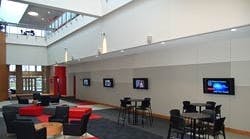Testing Facility Enables Greener Data Centers
The Schneider Electric Technology Center, which recently opened in O’Fallon, Mo., is a facility for conducting training, demonstrations, research and development and evaluations relating to power-reduction technologies for existing and future data centers. The facility can host educational sessions for both technicians and executive decision makers (Figure 1), and the range of technologies that can be evaluated spans from power and cooling management software, to power conversion hardware to complete data-center HVAC systems. While these capabilities represent a diverse range, they all share the goal of efficiency and automation of enterprise networks.
“With industry experts predicting that the cost of powering and cooling data centers will soon surpass the cost of the equipment housed in them, properly selecting, configuring and testing physical infrastructure is more important than ever,” says Laurent Vernerey, president and CEO of APC-MGE. “Improperly planning the powering and cooling of a data center can dramatically increase costs and decrease performance of the facility, not to mention injecting new areas of risk and potential downtime. It is our objective to keep that from happening through both applied research and practical testing. With live testing of customer-specific physical infrastructure designs, the Schneider Electric Technology Center will dramatically enhance our customers’ ability to design and build data centers and ultimately enhance the effectiveness and performance of the entire installation.”
Rob Johnson, senior vice president and president of APC-MGE’s North American division, states that data centers designed for energy efficiency at the onset—collectively referred to as the “greenfield”—provide the most effective approach for reducing data-center energy use. However, Johnson also states that as many as 80% of all data-center-efficiency projects are retrofits to existing facilities, which are collectively referred to as the “brownfield”. To address this division, the technology center can fully support projects from both groups.
For example, a new data center requires the selection of a complete cooling system and a complete power delivery system. Decision makers can visit the technology center to see real demonstrations of these systems and their components, including high-efficiency UPS systems (such as APC’s Symmetra PX 250 kW/500 kW system, with 96% efficiency down to 40% load), and precision cooling systems that confine cold air flow to equipment racks without the need for a raised-floor environment (such as the InRow cooling system from APC).
Furthermore, a large, dual-chambered climate control system allows a complete HVAC platform to be fully tested for a range of indoor and outdoor conditions. Vistors to the center can also see APC’s Capacity Manager and Change Manager software that can integrate and manage both the power delivery system and the HVAC system of a data center to reduce data center power consumption below what is possible when these two systems are functionally isolated. The technology center also provides both executive decision makers and system integrators the means to evaluate their hardware selections under the control of this software. Such evaluations therefore have the potential to actually streamline and integrate the very processes of system design and equipment acquisition.
For retrofit projects, system integrators might use these same capabilities on a smaller scale to evaluate power-system or cooling-system components from different vendors to achieve efficiency upgrade targets. The technology center can also be used by the vendors themselves to optimize their designs based on performance in a complete working data center system (Figure 2).
The center can also be used to test new technologies—or new applications for existing technologies—that have the potential to improve data center efficiency. Johnson states that Schneider Electric will monitor these emerging technologies, and that the technology center can support them throughout their development. Just as the technology center supports the data-center upgrades of its clients, the 100,000 square-foot center itself is equipped with features such as overhead doors, so that all electrical and mechanical equipment (except for the physical structure of the building) can be completely replaced with newer technology.
As an example of this technology, microturbines (such as those provided by Capstone) are increasingly deployed as a way to manage data center power peaks. Also, waste-heat recovery systems and fuel cells operating from natural gas are becoming available for supplementary or backup power generation.
Another trend, common in India, is the use of photovoltaic (PV) systems as part of the data center power system. The use of the abundant solar resource in India enables data centers so equipped to reduce the demand on the power grid. Johnson states that Schneider can directly contribute to this trend by supplying components that perform the inverter function needed in PV systems, and that the technology center can be used to evaluate the effectiveness of such systems.
However, regardless of the exact nature of future equipment installed or tested at the technology center, the focus of activity will always remain the automation and efficiency of the enterprise network.
